
Architecture of Provence
Encyclopedia

Roman Empire
The Roman Empire was the post-Republican period of the ancient Roman civilization, characterised by an autocratic form of government and large territorial holdings in Europe and around the Mediterranean....
; Cistercian monasteries from the Romanesque
Romanesque architecture
Romanesque architecture is an architectural style of Medieval Europe characterised by semi-circular arches. There is no consensus for the beginning date of the Romanesque architecture, with proposals ranging from the 6th to the 10th century. It developed in the 12th century into the Gothic style,...
Period, medieval
Middle Ages
The Middle Ages is a periodization of European history from the 5th century to the 15th century. The Middle Ages follows the fall of the Western Roman Empire in 476 and precedes the Early Modern Era. It is the middle period of a three-period division of Western history: Classic, Medieval and Modern...
palaces and churches; fortifications from the time of Louis XIV
Louis XIV of France
Louis XIV , known as Louis the Great or the Sun King , was a Bourbon monarch who ruled as King of France and Navarre. His reign, from 1643 to his death in 1715, began at the age of four and lasted seventy-two years, three months, and eighteen days...
, as well as numerous hilltop villages and fine churches. Provence
Provence
Provence ; Provençal: Provença in classical norm or Prouvènço in Mistralian norm) is a region of south eastern France on the Mediterranean adjacent to Italy. It is part of the administrative région of Provence-Alpes-Côte d'Azur...
was a very poor region after the 18th century, but in the 20th century it had an economic revival and became the site of one of the most influential buildings of the 20th century, the Unité d'Habitation
Unité d'Habitation
The Unité d'Habitation is the name of a modernist residential housing design principle developed by Le Corbusier, with the collaboration of painter-architect Nadir Afonso...
of the architect Le Corbusier
Le Corbusier
Charles-Édouard Jeanneret, better known as Le Corbusier , was a Swiss-born French architect, designer, urbanist, writer and painter, famous for being one of the pioneers of what now is called modern architecture. He was born in Switzerland and became a French citizen in 1930...
in Marseille
Marseille
Marseille , known in antiquity as Massalia , is the second largest city in France, after Paris, with a population of 852,395 within its administrative limits on a land area of . The urban area of Marseille extends beyond the city limits with a population of over 1,420,000 on an area of...
.
Provence in the southeast corner of France
France
The French Republic , The French Republic , The French Republic , (commonly known as France , is a unitary semi-presidential republic in Western Europe with several overseas territories and islands located on other continents and in the Indian, Pacific, and Atlantic oceans. Metropolitan France...
, is generally defined as the French Departments of Var, Bouches-du-Rhône
Bouches-du-Rhône
Bouches-du-Rhône is a department in the south of France named after the mouth of the Rhône River. It is the most populous department of the Provence-Alpes-Côte d'Azur region. Its INSEE and postal code is 13.-History of the department:...
, Vaucluse
Vaucluse
The Vaucluse is a department in the southeast of France, named after the famous spring, the Fontaine-de-Vaucluse.- History :Vaucluse was created on 12 August 1793 out of parts of the departments of Bouches-du-Rhône, Drôme, and Basses-Alpes...
, and part of Alpes-de-Haute-Provence
Alpes-de-Haute-Provence
Alpes-de-Haute-Provence is a French department in the south of France, it was formerly part of the province of Provence.- History :Nord-de-Provence was one of the 83 original departments created during the French Revolution on 4 March 1790...
and Alpes-Maritimes
Alpes-Maritimes
Alpes-Maritimes is a department in the extreme southeast corner of France.- History : was created by Octavian as a Roman military district in 14 BC, and became a full Roman province in the middle of the 1st century with its capital first at Cemenelum and subsequently at Embrun...
. The original comté de Provence extended from the west bank of the Rhone
Rhône
Rhone can refer to:* Rhone, one of the major rivers of Europe, running through Switzerland and France* Rhône Glacier, the source of the Rhone River and one of the primary contributors to Lake Geneva in the far eastern end of the canton of Valais in Switzerland...
River to the east bank of the Var
Var River
The Var is a river located in the southeast of France. The name Var originates from the Ligurian word for waterway.The Var flows through the Alpes-Maritimes département for most of its length, with a short stretch in the Alpes-de-Haute-Provence département...
river, bordering the comté of Nice
County of Nice
The County of Nice or Niçard Country is a historical region of France, located in the south-eastern part, around the city of Nice.-History:Its territory lies between the Mediterranean Sea , Var River and the southernmost crest of the...
. Provence culturally and historically extended further west of the Gard
Gard
Gard is a département located in southern France in the Languedoc-Roussillon region.The department is named after the River Gard, although the formerly Occitan name of the River Gard, Gardon, has been replacing the traditional French name in recent decades, even among French speakers.- History...
to Nîmes
Nîmes
Nîmes is the capital of the Gard department in the Languedoc-Roussillon region in southern France. Nîmes has a rich history, dating back to the Roman Empire, and is a popular tourist destination.-History:...
and to the Vidourle
Vidourle
The Vidourle is a river in southern France, flowing into the Mediterranean Sea in Le Grau-du-Roi. Its source is in the Cévennes mountains, northwest of Saint-Hippolyte-du-Fort, at Saint-Roman-de-Codières. It flows generally southeast...
river.
Prehistoric and ancient sites in Provence (27,000 BC to the 2nd century BC)
Remains of a prehistoricPrehistory
Prehistory is the span of time before recorded history. Prehistory can refer to the period of human existence before the availability of those written records with which recorded history begins. More broadly, it refers to all the time preceding human existence and the invention of writing...
settlement dating to between 27,000 and 19,000 BC were found by divers in 1991 at the Cosquer Cave
Cosquer Cave
The Cosquer cave is located in the Calanque de Morgiou near Marseille, France, not very far from Cap Morgiou. The entrance to the cave is located 37 meters underwater, due to the rise of the Mediterranean in Paleolithic times. It was discovered by diver Henri Cosquer in 1985, but its...
, an underwater cave in a calanque
Calanque
A calanque is a steep-walled inlet, cove, or bay that is developed in limestone, dolomite, or other carbonate strata and found along the Mediterranean coast...
on the coast near Marseille
Marseille
Marseille , known in antiquity as Massalia , is the second largest city in France, after Paris, with a population of 852,395 within its administrative limits on a land area of . The urban area of Marseille extends beyond the city limits with a population of over 1,420,000 on an area of...
.
A neolithic
Neolithic
The Neolithic Age, Era, or Period, or New Stone Age, was a period in the development of human technology, beginning about 9500 BC in some parts of the Middle East, and later in other parts of the world. It is traditionally considered as the last part of the Stone Age...
site dating to about 6000 BC. was discovered in Marseille near the current Saint Charles railway station, which has remains of walls made of baked clay with holes for posts, as well as tools.
Marseille was founded in about 546 BC by Greek colonists coming from the city of Phocaea
Phocaea
Phocaea, or Phokaia, was an ancient Ionian Greek city on the western coast of Anatolia. Greek colonists from Phocaea founded the colony of Massalia in 600 BC, Emporion in 575 BC and Elea in 540 BC.-Geography:Phocaea was the northernmost...
(now Foça, in modern Turkey) on the Aegean coast of Asia Minor
Anatolia
Anatolia is a geographic and historical term denoting the westernmost protrusion of Asia, comprising the majority of the Republic of Turkey...
, who were fleeing an invasion by the Persians
Persian people
The Persian people are part of the Iranian peoples who speak the modern Persian language and closely akin Iranian dialects and languages. The origin of the ethnic Iranian/Persian peoples are traced to the Ancient Iranian peoples, who were part of the ancient Indo-Iranians and themselves part of...
. They called their settlement Massalia.
Traces of the original settlement have been found on the west side of the butte Saint-Laurent in Marseille. The original settlement extended to the east toward the butte des Moulins and finally the butte des Carmes, covering about fifty hectares. The size of the original settlement were not exceeded until the 17th century.
Remains of the ancient Phocaean fortifications of Massalia dating to the end of the 7th century BC can be seen in the Jardin des Vestiges and on the butte des Carmes. In the 2nd century BC the entire system of fortifications were rebuilt in pink limestone. Parts of the ramparts can still be seen in the Jardin des Vestiges.
According to the historian Strabo
Strabo
Strabo, also written Strabon was a Greek historian, geographer and philosopher.-Life:Strabo was born to an affluent family from Amaseia in Pontus , a city which he said was situated the approximate equivalent of 75 km from the Black Sea...
and other ancient sources, the city of Massalia had temples to Apollo
Apollo
Apollo is one of the most important and complex of the Olympian deities in Greek and Roman mythology...
and Artemis
Artemis
Artemis was one of the most widely venerated of the Ancient Greek deities. Her Roman equivalent is Diana. Some scholars believe that the name and indeed the goddess herself was originally pre-Greek. Homer refers to her as Artemis Agrotera, Potnia Theron: "Artemis of the wildland, Mistress of Animals"...
, but no trace of them remains. The only remaining structure from ancient Massalia are the cellars of Saint-Sauveur, near the Place de Lenche in Marseille. They probably served as either a granary or an arsenal.
The Phocaea
Phocaea
Phocaea, or Phokaia, was an ancient Ionian Greek city on the western coast of Anatolia. Greek colonists from Phocaea founded the colony of Massalia in 600 BC, Emporion in 575 BC and Elea in 540 BC.-Geography:Phocaea was the northernmost...
ns,also established colonies at Nice
Nice
Nice is the fifth most populous city in France, after Paris, Marseille, Lyon and Toulouse, with a population of 348,721 within its administrative limits on a land area of . The urban area of Nice extends beyond the administrative city limits with a population of more than 955,000 on an area of...
, Arles
Arles
Arles is a city and commune in the south of France, in the Bouches-du-Rhône department, of which it is a subprefecture, in the former province of Provence....
, Cannes
Cannes
Cannes is one of the best-known cities of the French Riviera, a busy tourist destination and host of the annual Cannes Film Festival. It is a Commune of France in the Alpes-Maritimes department....
and south of Nîmes
Nîmes
Nîmes is the capital of the Gard department in the Languedoc-Roussillon region in southern France. Nîmes has a rich history, dating back to the Roman Empire, and is a popular tourist destination.-History:...
. Later the region was also inhabited by Celts, who were also known as the Ligures
Ligures
The Ligures were an ancient people who gave their name to Liguria, a region of north-western Italy.-Classical sources:...
s or Celto-Ligurians. who built oppida
Oppidum
Oppidum is a Latin word meaning the main settlement in any administrative area of ancient Rome. The word is derived from the earlier Latin ob-pedum, "enclosed space," possibly from the Proto-Indo-European *pedóm-, "occupied space" or "footprint."Julius Caesar described the larger Celtic Iron Age...
, or forts. Little trace remains of their architecture.
Roman monuments in Provence (20 BC to 476 AD)

Ancient Rome
Ancient Rome was a thriving civilization that grew on the Italian Peninsula as early as the 8th century BC. Located along the Mediterranean Sea and centered on the city of Rome, it expanded to one of the largest empires in the ancient world....
began their conquest of the region, sending legions which defeated the Ligurians and destroyed their fortresses. In 123 BC the Romans founded Aix-en-Provence
Aix-en-Provence
Aix , or Aix-en-Provence to distinguish it from other cities built over hot springs, is a city-commune in southern France, some north of Marseille. It is in the region of Provence-Alpes-Côte d'Azur, in the département of Bouches-du-Rhône, of which it is a subprefecture. The population of Aix is...
, and two years later began a new town at Nemausa (today Nîmes
Nîmes
Nîmes is the capital of the Gard department in the Languedoc-Roussillon region in southern France. Nîmes has a rich history, dating back to the Roman Empire, and is a popular tourist destination.-History:...
.) The Roman colony known as Provincia was organized in about 120 BC. A Roman road, the Via Domitia, named for Roman Consul Domitius Ahenobarbus, was built to connect Rome with the Pyrenees
Pyrenees
The Pyrenees is a range of mountains in southwest Europe that forms a natural border between France and Spain...
, following the path of the old Greek Way of Hercules. It led to a great expansion of commerce in the region.
In the 1st century BC, Roman legion
Roman legion
A Roman legion normally indicates the basic ancient Roman army unit recruited specifically from Roman citizens. The organization of legions varied greatly over time but they were typically composed of perhaps 5,000 soldiers, divided into maniples and later into "cohorts"...
s completed the conquest of Gaul and began building towns, triumphal arch
Triumphal arch
A triumphal arch is a monumental structure in the shape of an archway with one or more arched passageways, often designed to span a road. In its simplest form a triumphal arch consists of two massive piers connected by an arch, crowned with a flat entablature or attic on which a statue might be...
es, amphitheatre
Amphitheatre
An amphitheatre is an open-air venue used for entertainment and performances.There are two similar, but distinct, types of structure for which the word "amphitheatre" is used: Ancient Roman amphitheatres were large central performance spaces surrounded by ascending seating, and were commonly used...
s, theaters
Theatre
Theatre is a collaborative form of fine art that uses live performers to present the experience of a real or imagined event before a live audience in a specific place. The performers may communicate this experience to the audience through combinations of gesture, speech, song, music or dance...
, baths
Public bathing
Public baths originated from a communal need for cleanliness. The term public may confuse some people, as some types of public baths are restricted depending on membership, gender, religious affiliation, or other reasons. As societies have changed, public baths have been replaced as private bathing...
and aqueduct
Aqueduct
An aqueduct is a water supply or navigable channel constructed to convey water. In modern engineering, the term is used for any system of pipes, ditches, canals, tunnels, and other structures used for this purpose....
s in Provence.
The Roman aqueduct of Pont du Gard
Pont du Gard
The Pont du Gard is a notable ancient Roman aqueduct bridge that crosses the Gard River in southern France. It is part of a long aqueduct that runs between Uzès and Nîmes in the South of France. It is located in Vers-Pont-du-Gard near Remoulins, in the Gard département...
(1st century AD), built during the time of the Emperor Claudius
Claudius
Claudius , was Roman Emperor from 41 to 54. A member of the Julio-Claudian dynasty, he was the son of Drusus and Antonia Minor. He was born at Lugdunum in Gaul and was the first Roman Emperor to be born outside Italy...
, is one of the most impressive examples of Roman civil engineering. Fifty meters above the River Gard, it is the highest existing Roman aqueduct. The aqueduct carried water a distance of fifty kilometers.

Triumphal Arch of Orange
The Triumphal Arch of Orange is a triumphal arch located in the town of Orange, southeast France. There is debate about when the arch was built, but current research that accepts the inscription as evidence favours a date during the reign of Augustus . It was built on the former via Agrippa to...
at Orange
Orange, Vaucluse
Orange is a commune in the Vaucluse department in the Provence-Alpes-Côte d'Azur region in southeastern France.It has a primarily agricultural economy...
, Vaucluse
Vaucluse
The Vaucluse is a department in the southeast of France, named after the famous spring, the Fontaine-de-Vaucluse.- History :Vaucluse was created on 12 August 1793 out of parts of the departments of Bouches-du-Rhône, Drôme, and Basses-Alpes...
, was probably built to honor the veterans of the 11th legion in about twenty BC, during the time of the Emperor Augustus
Augustus
Augustus ;23 September 63 BC – 19 August AD 14) is considered the first emperor of the Roman Empire, which he ruled alone from 27 BC until his death in 14 AD.The dates of his rule are contemporary dates; Augustus lived under two calendars, the Roman Republican until 45 BC, and the Julian...
, and was later dedicated to the Emperor Tiberius
Tiberius
Tiberius , was Roman Emperor from 14 AD to 37 AD. Tiberius was by birth a Claudian, son of Tiberius Claudius Nero and Livia Drusilla. His mother divorced Nero and married Augustus in 39 BC, making him a step-son of Octavian...
. It was designed to show travellers to the new Roman province the superiority and power of Rome.
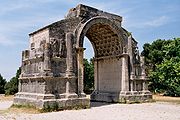
Glanum
Glanum was an oppidum, or fortified town, founded by a Celto-Ligurian people called the Salyens in the 6th century B.C.,. It was known for the healing power of its spring. It became a Roman city in Provence until its abandonment in 260 A.D....
, just outside Saint-Rémy-de-Provence
Saint-Rémy-de-Provence
Saint-Rémy-de-Provence is a commune in the Bouches-du-Rhône department in southern France.-Geography:...
, shows Roman soldiers leading away defeated prisoners. It was constructed between 10 and 25 AD, sometime after the Romans had conquered the town, which was inhabited by Celto-Ligurians
Ligures
The Ligures were an ancient people who gave their name to Liguria, a region of north-western Italy.-Classical sources:...
. Glanum was destroyed in 260 AD. by the Alamanni
Alamanni
The Alamanni, Allemanni, or Alemanni were originally an alliance of Germanic tribes located around the upper Rhine river . One of the earliest references to them is the cognomen Alamannicus assumed by Roman Emperor Caracalla, who ruled the Roman Empire from 211 to 217 and claimed thereby to be...
, a Germanic tribe, as the Roman Empire began to crumble.

Augustus
Augustus ;23 September 63 BC – 19 August AD 14) is considered the first emperor of the Roman Empire, which he ruled alone from 27 BC until his death in 14 AD.The dates of his rule are contemporary dates; Augustus lived under two calendars, the Roman Republican until 45 BC, and the Julian...
in the early 1st century BC, is the best-preserved Roman theater in Europe. It was closed by the authorities of the Christian church in 391 because of its "barbaric spectacles," and not re-opened until the 19th century. Today it is the home of music and theater festivals.
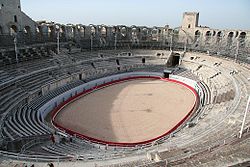
Arles Amphitheatre
The Arles Amphitheatre is a Roman amphitheatre in the southern French town of Arles. This two-tiered Roman Amphitheatre is probably the most prominent tourist attraction in the city of Arles, which thrived in Roman times....
was built in the 1st and 2nd centuries AD, when Arles was the capital of Roman Provence. It was used for combat by gladiators and other spectacles. It has a diameter of 102 meters, and could hold twelve thousand spectators.
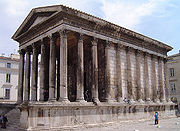
Maison Carrée
The Maison Carrée is an ancient building in Nîmes, southern France; it is one of the best preserved temples to be found anywhere in the territory of the former Roman Empire.- History :...
in Nîmes
Nîmes
Nîmes is the capital of the Gard department in the Languedoc-Roussillon region in southern France. Nîmes has a rich history, dating back to the Roman Empire, and is a popular tourist destination.-History:...
, built in 16-19 BC, is one of the best-preserved Roman temples in the former Roman Empire. It survived intact because it was converted into a Christian church in the 4th century AD. It was built according to the principles of Vitruvius
Vitruvius
Marcus Vitruvius Pollio was a Roman writer, architect and engineer, active in the 1st century BC. He is best known as the author of the multi-volume work De Architectura ....
, the chief theorician of Roman architecture. In the early 19th century, it was chosen as the model for the church of the Madeleine
Église de la Madeleine
L'église de la Madeleine is a Roman Catholic church occupying a commanding position in the 8th arrondissement of Paris. It was designed in its present form as a temple to the glory of Napoleon's army...
in Paris
Paris
Paris is the capital and largest city in France, situated on the river Seine, in northern France, at the heart of the Île-de-France region...
.
Romanesque architecture in Provence (5th-13th centuries)
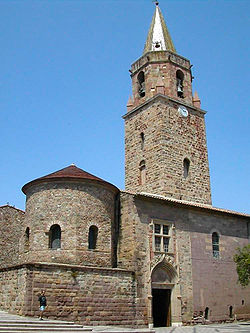


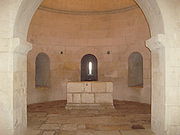
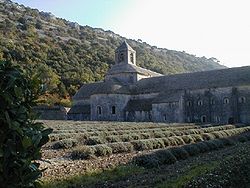
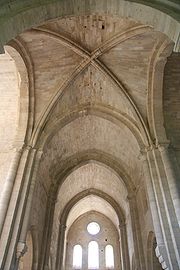
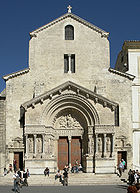
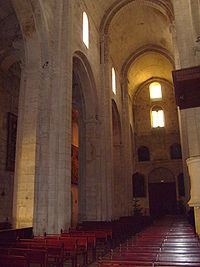
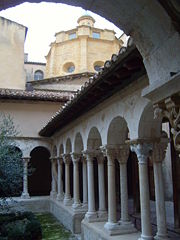

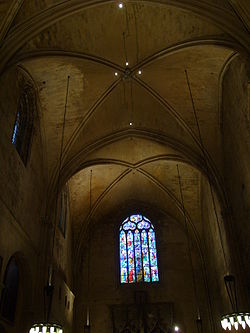
Christianity
Christianity is a monotheistic religion based on the life and teachings of Jesus as presented in canonical gospels and other New Testament writings...
became the official religion of the Roman Empire, and Christian churches, cathedral
Cathedral
A cathedral is a Christian church that contains the seat of a bishop...
s and monasteries
Monastery
Monastery denotes the building, or complex of buildings, that houses a room reserved for prayer as well as the domestic quarters and workplace of monastics, whether monks or nuns, and whether living in community or alone .Monasteries may vary greatly in size – a small dwelling accommodating only...
were founded all across Provence.
Sometimes Roman temples, such as the temple at Nîmes, were turned into churches. Often churches were built on the sites of Roman temples or fora (Arles and Aix-en-Provence) and used columns, such as the columns in the baptistery at Frejus, and other elements of Roman temples.
Many of the churches were built in a new style, later called Romanesque
Romanesque architecture
Romanesque architecture is an architectural style of Medieval Europe characterised by semi-circular arches. There is no consensus for the beginning date of the Romanesque architecture, with proposals ranging from the 6th to the 10th century. It developed in the 12th century into the Gothic style,...
, which combined Gallo-Roman architectural elements with elements of a new style coming from Lombardy
Lombardy
Lombardy is one of the 20 regions of Italy. The capital is Milan. One-sixth of Italy's population lives in Lombardy and about one fifth of Italy's GDP is produced in this region, making it the most populous and richest region in the country and one of the richest in the whole of Europe...
in Italy. It was particularly influenced by the new churches in the Byzantine
Byzantine Empire
The Byzantine Empire was the Eastern Roman Empire during the periods of Late Antiquity and the Middle Ages, centred on the capital of Constantinople. Known simply as the Roman Empire or Romania to its inhabitants and neighbours, the Empire was the direct continuation of the Ancient Roman State...
style in Ravenna
Ravenna
Ravenna is the capital city of the Province of Ravenna in the Emilia-Romagna region of Italy and the second largest comune in Italy by land area, although, at , it is little more than half the size of the largest comune, Rome...
.
The Romanesque style in Provence and the valley of the Rhône had some regional decorative elements, borrowed from the Gallo-Romans
Gallo-Roman culture
The term Gallo-Roman describes the Romanized culture of Gaul under the rule of the Roman Empire. This was characterized by the Gaulish adoption or adaptation of Roman mores and way of life in a uniquely Gaulish context...
; particularly the use of eagles and busts, traditional ancient Roman elements, to decorate the capitals of Corinthian columns
Corinthian order
The Corinthian order is one of the three principal classical orders of ancient Greek and Roman architecture. The other two are the Doric and Ionic. When classical architecture was revived during the Renaissance, two more orders were added to the canon, the Tuscan order and the Composite order...
.
The Baptistry
Baptistery
In Christian architecture the baptistry or baptistery is the separate centrally-planned structure surrounding the baptismal font. The baptistry may be incorporated within the body of a church or cathedral and be provided with an altar as a chapel...
of the Cathedral of Saint-Léonce
Fréjus Cathedral
Fréjus Cathedral is a Roman Catholic cathedral, and a national monument of France, situated in the town of Fréjus in the Var department of Provence, in southeast France....
at Frejus
Fréjus
Fréjus is a commune in the Var department in the Provence-Alpes-Côte d'Azur region in southeastern France.It neighbours Saint-Raphaël, effectively forming one town...
(406-409 AD), built shortly before the fall of the Roman Empire
Roman Empire
The Roman Empire was the post-Republican period of the ancient Roman civilization, characterised by an autocratic form of government and large territorial holdings in Europe and around the Mediterranean....
, is the oldest Christian
Christian
A Christian is a person who adheres to Christianity, an Abrahamic, monotheistic religion based on the life and teachings of Jesus of Nazareth as recorded in the Canonical gospels and the letters of the New Testament...
structure in Provence, and one of the oldest buildings in France. The octagonal building, about seven meters across, is covered by a dome set on arches supported by columns. In the center of the building is an octagonal baptismal font 1.3 meters deep and 92 centimeters long, large enough for the person baptized to be immersed in the water. It was only discovered in 1925, hidden behind later modifications to the church, and restored.
Montmajour Abbey
Montmajour Abbey
Montmajour Abbey is a fortified Benedictine monastery built between the 10th and 13th century on what was then an island five kilometers north of Arles, in the Bouches-du-Rhône département, Provence, in the south of France.The Abbey is noted for its 11th-14th century graves, carved in the rock,...
(French: Abbaye Notre Dame de Montmajour) is a fortified Benedictine
Benedictine
Benedictine refers to the spirituality and consecrated life in accordance with the Rule of St Benedict, written by Benedict of Nursia in the sixth century for the cenobitic communities he founded in central Italy. The most notable of these is Monte Cassino, the first monastery founded by Benedict...
monastery built between the 10th and 13th century on what was then an island five kilometers north of Arles
Arles
Arles is a city and commune in the south of France, in the Bouches-du-Rhône department, of which it is a subprefecture, in the former province of Provence....
, in the Bouches-du-Rhône
Bouches-du-Rhône
Bouches-du-Rhône is a department in the south of France named after the mouth of the Rhône River. It is the most populous department of the Provence-Alpes-Côte d'Azur region. Its INSEE and postal code is 13.-History of the department:...
département.
The Abbey is famous for its 11th-14th century graves, carved in the rock, its subterranean crypt, and its massive unfinished church. It was an important pilgrimage site during the Middle Ages, and in the 18th century it was the site of a large Maurist Monastery, now in ruins.
In the 12th century, monks of the Benedictine
Benedictine
Benedictine refers to the spirituality and consecrated life in accordance with the Rule of St Benedict, written by Benedict of Nursia in the sixth century for the cenobitic communities he founded in central Italy. The most notable of these is Monte Cassino, the first monastery founded by Benedict...
Order broke away to form a new order, the Cistercians, who adhered strictly to the rules of St. Benedict. Cistercian monasteries were located in remote valleys next to rivers, were devoted to prayer, meditation and manual labor, and were built following religious principles to avoid anything that would distract the monks from their prayers.
Sénanque Abbey
Sénanque Abbey
Sénanque Abbey is a Cistercian abbey near the village of Gordes in the département of the Vaucluse in Provence, France.-First foundation:...
was the first Cistercian monastery founded in Provence, in 1148. The church was finished in 1178. A small community of monks still lives in the Abbey. The lavender fields around the Abbey make it one of the most photographed spots in Provence.
Le Thoronet Abbey
Le Thoronet Abbey
Le Thoronet Abbey is a former Cistercian abbey built in the late twelfth and early thirteenth century, now restored as a museum. It is sited between the towns of Draguignan and Brignoles in the Var Department of Provence, in southeast France...
, in a remote valley near Draguignan
Draguignan
Draguignan is a commune in the Var department in the Provence-Alpes-Côte d'Azur region, in southeastern France.It is a sub-prefecture of the department and self-proclaimed "capital of Artillery" and "Porte du Verdon".The city is only from St...
, in the Var department, was founded in 1160. The cloister is among the oldest cistercian cloisters still existing. Le Corbusier
Le Corbusier
Charles-Édouard Jeanneret, better known as Le Corbusier , was a Swiss-born French architect, designer, urbanist, writer and painter, famous for being one of the pioneers of what now is called modern architecture. He was born in Switzerland and became a French citizen in 1930...
visited the monastery in 1953, and imitated the play of light and shadow in his priory of Sainte Marie de La Tourette
Sainte Marie de La Tourette
Sainte Marie de La Tourette is a Dominican Order priory in a valley near Lyon, France designed by architects Le Corbusier and Iannis Xenakis and constructed between 1956 and 1960. Le Corbusier's design of the building began in May, 1953 with sketches drawn at Arbresle, France outlining the basic...
, near Lyon. It also influenced the modern monastery by John Pawson
John Pawson
John Pawson is a British designer associated with the minimalist aesthetic.-Biography:Pawson studied at Eton College and the Architectural Association School of Architecture and is married to Catherine and has two children, Caius and Benedict.-Selected projects:London's Cannelle Cake Shop, several...
at Novy Dvur
Nový Dvur Monastery
The Monastery of Nový Dvůr is the only monastery of the Trappist Order in the Czech Republic, located near Toužim in the Karlovy Vary Region, close to the Premonstratensian monastery of Teplá....
, in the Czech Republic. Thoronet is now a museum, open to visitors.
Silvacane Abbey
Silvacane Abbey
Silvacane Abbey is a former Cistercian monastery in the municipality of La Roque-d'Anthéron, Bouches-du-Rhône, in Provence, France. It was founded in or around 1144 as a daughter house of Morimond Abbey and was dissolved in 1443; it ceased to be an ecclesiastical property in the French Revolution...
was founded in 1175, the third of the Cistercian monasteries known as the Three Sisters of Provence. It is located by the Durance River at La Roque-d'Anthéron
La Roque-d'Anthéron
La Roque-d'Anthéron is a commune in the Bouches-du-Rhône department in southern France. Silvacane Abbey, a former Cistercian monastery, is located near La Roque-d'Anthéron.-Population:-References:*...
, between Avignon
Avignon
Avignon is a French commune in southeastern France in the départment of the Vaucluse bordered by the left bank of the Rhône river. Of the 94,787 inhabitants of the city on 1 January 2010, 12 000 live in the ancient town centre surrounded by its medieval ramparts.Often referred to as the...
and Aix-en-Provence
Aix-en-Provence
Aix , or Aix-en-Provence to distinguish it from other cities built over hot springs, is a city-commune in southern France, some north of Marseille. It is in the region of Provence-Alpes-Côte d'Azur, in the département of Bouches-du-Rhône, of which it is a subprefecture. The population of Aix is...
. It is open to the public, and is the only one of the three that no longer serves a religious purpose. It hosts prestigious piano and vocal festivals.
The Church of St. Trophime
Church of St. Trophime
The Church of St. Trophime is a Roman Catholic church and former cathedral built between the 12th century and the 15th century in the city of Arles, in the Bouches-du-Rhône Department of southern France...
(Trophimus) is a Roman Catholic
Roman Catholic Church
The Catholic Church, also known as the Roman Catholic Church, is the world's largest Christian church, with over a billion members. Led by the Pope, it defines its mission as spreading the gospel of Jesus Christ, administering the sacraments and exercising charity...
church and former cathedral
Cathedral
A cathedral is a Christian church that contains the seat of a bishop...
built between the 12th century and the 15th century in the city of Arles
Arles
Arles is a city and commune in the south of France, in the Bouches-du-Rhône department, of which it is a subprefecture, in the former province of Provence....
, in the Bouches-du-Rhône
Bouches-du-Rhône
Bouches-du-Rhône is a department in the south of France named after the mouth of the Rhône River. It is the most populous department of the Provence-Alpes-Côte d'Azur region. Its INSEE and postal code is 13.-History of the department:...
Department. The sculptures over the portal, particularly the Last Judgement
Last Judgment
The Last Judgment, Final Judgment, Day of Judgment, Judgment Day, or The Day of the Lord in Christian theology, is the final and eternal judgment by God of every nation. The concept is found in all the Canonical gospels, particularly the Gospel of Matthew. It will purportedly take place after the...
, and the columns in the adjacent cloister, are considered some of the finest examples of Romanesque sculpture
Romanesque art
Romanesque art refers to the art of Western Europe from approximately 1000 AD to the rise of the Gothic style in the 13th century, or later, depending on region. The preceding period is increasingly known as the Pre-Romanesque...
.
The church was built upon the site of the 5th century basilica
Basilica
The Latin word basilica , was originally used to describe a Roman public building, usually located in the forum of a Roman town. Public basilicas began to appear in Hellenistic cities in the 2nd century BC.The term was also applied to buildings used for religious purposes...
of Arles, named for St. Stephen
Saint Stephen
Saint Stephen The Protomartyr , the protomartyr of Christianity, is venerated as a saint in the Roman Catholic, Anglican, Lutheran, Oriental Orthodox and Eastern Orthodox Churches....
. In the 15th century a gothic choir was added to the Romanesque nave.
Aix Cathedral (Cathédrale Saint-Sauveur d'Aix) in Aix-en-Provence
Aix-en-Provence
Aix , or Aix-en-Provence to distinguish it from other cities built over hot springs, is a city-commune in southern France, some north of Marseille. It is in the region of Provence-Alpes-Côte d'Azur, in the département of Bouches-du-Rhône, of which it is a subprefecture. The population of Aix is...
, shows the transition from Romanesque to Gothic. It is built on the site of the 1st century Roman forum
Roman Forum
The Roman Forum is a rectangular forum surrounded by the ruins of several important ancient government buildings at the center of the city of Rome. Citizens of the ancient city referred to this space, originally a marketplace, as the Forum Magnum, or simply the Forum...
of Aix, and was re-built from the 12th until the 19th century, it includes Romanesque
Romanesque architecture
Romanesque architecture is an architectural style of Medieval Europe characterised by semi-circular arches. There is no consensus for the beginning date of the Romanesque architecture, with proposals ranging from the 6th to the 10th century. It developed in the 12th century into the Gothic style,...
, Gothic
Gothic architecture
Gothic architecture is a style of architecture that flourished during the high and late medieval period. It evolved from Romanesque architecture and was succeeded by Renaissance architecture....
and Neo-Gothic
Gothic Revival architecture
The Gothic Revival is an architectural movement that began in the 1740s in England...
elements, as well as Roman columns and parts of the baptistery
Baptistery
In Christian architecture the baptistry or baptistery is the separate centrally-planned structure surrounding the baptismal font. The baptistry may be incorporated within the body of a church or cathedral and be provided with an altar as a chapel...
from a 6th century Christian church.
Gothic architecture in Provence (12th-14th century)

Gothic architecture
Gothic architecture is a style of architecture that flourished during the high and late medieval period. It evolved from Romanesque architecture and was succeeded by Renaissance architecture....
style was invented in the middle of the 12th century with the facade of the Basilique Saint-Denis in Paris, and spread rapidly to England and Germany, but did not arrive in Provence until the late 13th century.
The first purely gothic church in Provence was the Basilica Sainte Marie-Madeleine in Saint-Maximin-la-Sainte-Baume
Saint-Maximin-la-Sainte-Baume
Saint-Maximin-la-Sainte-Baume is a commune in the Var department in the Provence-Alpes-Côte d'Azur region in southeastern France.It lies east of Aix-en-Provence, in the westernmost point of Var département. It is located at the foot of the Sainte-Baume mountains: baume or bama is the Provençal...
, which was begun in 1295. It was built to contain what was believed to be the sarcophagus of Mary Magdalene
Mary Magdalene
Mary Magdalene was one of Jesus' most celebrated disciples, and the most important woman disciple in the movement of Jesus. Jesus cleansed her of "seven demons", conventionally interpreted as referring to complex illnesses...
, which was discovered in a Gallo-Roman
Gallo-Roman culture
The term Gallo-Roman describes the Romanized culture of Gaul under the rule of the Roman Empire. This was characterized by the Gaulish adoption or adaptation of Roman mores and way of life in a uniquely Gaulish context...
crypt in Saint-Maximin in 1279. The basilica was consecrated in 1316, but the Black Death
Black Death
The Black Death was one of the most devastating pandemics in human history, peaking in Europe between 1348 and 1350. Of several competing theories, the dominant explanation for the Black Death is the plague theory, which attributes the outbreak to the bacterium Yersinia pestis. Thought to have...
in 1348, which killed half the local population, interrupted construction. Work started again in 1404, and the sixth bay of the nave
Nave
In Romanesque and Gothic Christian abbey, cathedral basilica and church architecture, the nave is the central approach to the high altar, the main body of the church. "Nave" was probably suggested by the keel shape of its vaulting...
was completed in 1412. Work continued until 1532, when it was decided to leave the basilica just as it was, with an unfinished west front, and neither a portal nor bell towers. The church today has a main apse flanked by two subsidiary apses. The nave has no transept, and is flanked by sixteen chapels in the aisles. In the crypt is displayed what is said to be the skull of St. Mary Magdalene.
In other parts of Provence, romanesque churches were made into gothic churches. In Aix-en-Provence, two new wings of the transept of Aix Cathedral were built in the gothic style between 1285-1230 and the cathedral was turned bay by bay into gothic church. paralleled the growth of importance of Aix. In Arles
Arles
Arles is a city and commune in the south of France, in the Bouches-du-Rhône department, of which it is a subprefecture, in the former province of Provence....
, a Gothic choir replaced the Romaneque abside of the Church of St. Trophime
Church of St. Trophime
The Church of St. Trophime is a Roman Catholic church and former cathedral built between the 12th century and the 15th century in the city of Arles, in the Bouches-du-Rhône Department of southern France...
between 1445 and 1465.
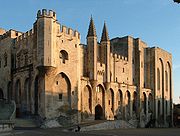
Palais des Papes
The Palais des Papes is a historical palace in Avignon, southern France, one of the largest and most important medieval Gothic buildings in Europe....
in Avignon
Avignon
Avignon is a French commune in southeastern France in the départment of the Vaucluse bordered by the left bank of the Rhône river. Of the 94,787 inhabitants of the city on 1 January 2010, 12 000 live in the ancient town centre surrounded by its medieval ramparts.Often referred to as the...
, constructed between 1334 and 1364, during the brief period from 1309 to 1377 when Avignon was the seat of the papal curia. It was one of the largest and most important buildings in Europe. Construction was begun by Pope Benedict XIII
Pope Benedict XIII
-Footnotes:...
, and continued by his successors. The construction of the 10 acres (40,468.6 m²), heavily-fortified palace consumed most of the income of the papacy during this period. It served as the residence of two antipope
Antipope
An antipope is a person who opposes a legitimately elected or sitting Pope and makes a significantly accepted competing claim to be the Pope, the Bishop of Rome and leader of the Roman Catholic Church. At times between the 3rd and mid-15th century, antipopes were typically those supported by a...
s, Clement VII
Pope Clement VII
Clement VII , born Giulio di Giuliano de' Medici, was a cardinal from 1513 to 1523 and was Pope from 1523 to 1534.-Early life:...
and Benedict XIII
Antipope Benedict XIII
Benedict XIII, born Pedro Martínez de Luna y Pérez de Gotor , known as in Spanish, was an Aragonese nobleman, who is officially considered by the Catholic Church to be an antipope....
, before the papacy
Pope
The Pope is the Bishop of Rome, a position that makes him the leader of the worldwide Catholic Church . In the Catholic Church, the Pope is regarded as the successor of Saint Peter, the Apostle...
finally returned permanently to Rome.
While the outside of the palace looked like a fortress, the inside was lavishly decorated with tapestries, sculptures, and decorated wooden ceilings.
The pont d'Avignon
Pont Saint-Bénezet
The Pont Saint-Bénezet , also known as the Pont d'Avignon , is a famous medieval bridge in the town of Avignon, in southern France.The bridge originally spanned the Rhône River between Avignon and Villeneuve-lès-Avignon on the left bank...
, also known as the Pont Saint-Bénézet
Pont Saint-Bénezet
The Pont Saint-Bénezet , also known as the Pont d'Avignon , is a famous medieval bridge in the town of Avignon, in southern France.The bridge originally spanned the Rhône River between Avignon and Villeneuve-lès-Avignon on the left bank...
,which crossed the Rhone
Rhône
Rhone can refer to:* Rhone, one of the major rivers of Europe, running through Switzerland and France* Rhône Glacier, the source of the Rhone River and one of the primary contributors to Lake Geneva in the far eastern end of the canton of Valais in Switzerland...
River between Avignon and Villeneuve
Villeneuve
-People:*Andrew Villeneuve, founder and executive director the Northwest Progressive Institute in the U.S.*Annie Villeneuve , Singer from Quebec, Canada*Denis Villeneuve , film director...
became one of the wonders of the medieval
Middle Ages
The Middle Ages is a periodization of European history from the 5th century to the 15th century. The Middle Ages follows the fall of the Western Roman Empire in 476 and precedes the Early Modern Era. It is the middle period of a three-period division of Western history: Classic, Medieval and Modern...
world. The Romans had built a wooden bridge across the Rhone at the same point, which was replaced by a stone Romanesque bridge built between 1177 and 1185. That bridge, except for four arches, was swept away by a flood in 1226. A new bridge was constructed in the gothic
Gothic architecture
Gothic architecture is a style of architecture that flourished during the high and late medieval period. It evolved from Romanesque architecture and was succeeded by Renaissance architecture....
style between 1234 and 1237, which was 900 meters long, resting on 22 arches. A chapel to Saint Nicholas
Saint Nicholas
Saint Nicholas , also called Nikolaos of Myra, was a historic 4th-century saint and Greek Bishop of Myra . Because of the many miracles attributed to his intercession, he is also known as Nikolaos the Wonderworker...
, with two chapels, one romanesque and the other gothic, was located on the bridge fourth arch, where a toll was collected from voyagers, in the form of a donation to the Saint.
During the Middle Ages the Avignon bridge was the only bridge across the Rhone between Lyon
Lyon
Lyon , is a city in east-central France in the Rhône-Alpes region, situated between Paris and Marseille. Lyon is located at from Paris, from Marseille, from Geneva, from Turin, and from Barcelona. The residents of the city are called Lyonnais....
and the mouth of the Rhone. It was also located on one of the main pilgrimage routes, between Italy and Saint-Jacques-Compostelle.
The bridge began to collapse in the 17th century; first one arch in 1603, then three more in 1605. These were repaired, but in 1669 a new flood carried away most of the bridge, leaving only four arches.
Hilltop villages (2nd century to 17th century)
As Roman authority crumbled in Provence, the region was flooded with invaders: Visigoths in the 5th century, FranksFranks
The Franks were a confederation of Germanic tribes first attested in the third century AD as living north and east of the Lower Rhine River. From the third to fifth centuries some Franks raided Roman territory while other Franks joined the Roman troops in Gaul. Only the Salian Franks formed a...
in the 6th century and Arab
Arab
Arab people, also known as Arabs , are a panethnicity primarily living in the Arab world, which is located in Western Asia and North Africa. They are identified as such on one or more of genealogical, linguistic, or cultural grounds, with tribal affiliations, and intra-tribal relationships playing...
s in the 8th century, and raids by Berber
Berber people
Berbers are the indigenous peoples of North Africa west of the Nile Valley. They are continuously distributed from the Atlantic to the Siwa oasis, in Egypt, and from the Mediterranean to the Niger River. Historically they spoke the Berber language or varieties of it, which together form a branch...
pirates and slavers. Rule eventually passed to the Counts of Toulouse
Toulouse
Toulouse is a city in the Haute-Garonne department in southwestern FranceIt lies on the banks of the River Garonne, 590 km away from Paris and half-way between the Atlantic Ocean and the Mediterranean Sea...
, and the Counts of Barcelona
Barcelona
Barcelona is the second largest city in Spain after Madrid, and the capital of Catalonia, with a population of 1,621,537 within its administrative limits on a land area of...
(later Kings of Aragon
Aragon
Aragon is a modern autonomous community in Spain, coextensive with the medieval Kingdom of Aragon. Located in northeastern Spain, the Aragonese autonomous community comprises three provinces : Huesca, Zaragoza, and Teruel. Its capital is Zaragoza...
).
Because of the repeated invasions, Provençal architecture was designed to resist attack. Monasteries were surrounded by towers and walls, and even the bishop's residence in Frejus resembled a fortress. Castles on hilltops surrounded by walled towns became the characteristic architectural feature of Provence. Only in the 17th century, after the wars of religion had ended and the French king had established his authority, were the towns of Provence safe from outside attack.
The village of Roussillon, Vaucluse
Roussillon, Vaucluse
Roussillon is a commune in the Vaucluse department in the Provence-Alpes-Côte d'Azur region in southeastern France.Roussillon lies within the borders of the Parc Naturel Régional du Luberon. In the French natural regional parks, new economic activities may be developed only if they are...
, in the Luberon
Luberon
The Luberon or Luberon Massif , also called Lubéron, has a maximum altitude of 1,256 m and an area of about 600 km²...
area, has vestiges of a 10th century chateau and an 11th century church. It is famous for its pinkish and yellow stone; in the 18th century, mines around the town produced pigment to make the color ochre
Ochre
Ochre is the term for both a golden-yellow or light yellow brown color and for a form of earth pigment which produces the color. The pigment can also be used to create a reddish tint known as "red ochre". The more rarely used terms "purple ochre" and "brown ochre" also exist for variant hues...
.
Les Baux-de-Provence, on a high rocky hilltop in the Bouches-du-Rhône
Bouches-du-Rhône
Bouches-du-Rhône is a department in the south of France named after the mouth of the Rhône River. It is the most populous department of the Provence-Alpes-Côte d'Azur region. Its INSEE and postal code is 13.-History of the department:...
Department, was inhabited as early as 6000 BC. and had a Celtic fort in the 2nd century AD. In the Middle Ages
Middle Ages
The Middle Ages is a periodization of European history from the 5th century to the 15th century. The Middle Ages follows the fall of the Western Roman Empire in 476 and precedes the Early Modern Era. It is the middle period of a three-period division of Western history: Classic, Medieval and Modern...
, the Lords of Les Baux, who claimed ancestry back to Balthazar
Biblical Magi
The Magi Greek: μάγοι, magoi), also referred to as the Wise Men, Kings, Astrologers, or Kings from the East, were a group of distinguished foreigners who were said to have visited Jesus after his birth, bearing gifts of gold, frankincense and myrrh...
, one of the Three Kings
Biblical Magi
The Magi Greek: μάγοι, magoi), also referred to as the Wise Men, Kings, Astrologers, or Kings from the East, were a group of distinguished foreigners who were said to have visited Jesus after his birth, bearing gifts of gold, frankincense and myrrh...
of the Nativity
Nativity of Jesus
The Nativity of Jesus, or simply The Nativity, refers to the accounts of the birth of Jesus in two of the Canonical gospels and in various apocryphal texts....
, ruled over a domain of 79 towns and villages. The Counts were deposed in the 12th century, the last princess died in the 15th century, and the town became part of France
France
The French Republic , The French Republic , The French Republic , (commonly known as France , is a unitary semi-presidential republic in Western Europe with several overseas territories and islands located on other continents and in the Indian, Pacific, and Atlantic oceans. Metropolitan France...
. In 1632, when the town became a Protestant
Protestantism
Protestantism is one of the three major groupings within Christianity. It is a movement that began in Germany in the early 16th century as a reaction against medieval Roman Catholic doctrines and practices, especially in regards to salvation, justification, and ecclesiology.The doctrines of the...
stronghold, Cardinal Richelieu ordered castle and town walls destroyed.
Gordes
Gordes
Gordes is a commune in the Vaucluse département in the Provence-Alpes-Côte d'Azur region in southeastern France.The residents are known as Gordiens...
, in the Vaucluse
Vaucluse
The Vaucluse is a department in the southeast of France, named after the famous spring, the Fontaine-de-Vaucluse.- History :Vaucluse was created on 12 August 1793 out of parts of the departments of Bouches-du-Rhône, Drôme, and Basses-Alpes...
, was originally a hilltop fort of the Celtic tribe of the Vordenses, then a Roman fort guarding the Roman road between Carpentras
Carpentras
Carpentras is a commune in the Vaucluse department in the Provence-Alpes-Côte d'Azur region in southeastern France.It stands on the banks of the Auzon...
and Apt
Apt, Vaucluse
Apt is a commune in the Vaucluse department in the Provence-Alpes-Côte d'Azur region in southeastern France.It lies on the left bank of the Calavon, east of Avignon...
. A castle was built by Guillaume d'Agoult in the 9th century which dominated the valley. In the 13th century, the town joined Savoy
Savoy
Savoy is a region of France. It comprises roughly the territory of the Western Alps situated between Lake Geneva in the north and Monaco and the Mediterranean coast in the south....
e in a war against France. In the 14th century, during the Hundred Years War
Hundred Years' War
The Hundred Years' War was a series of separate wars waged from 1337 to 1453 by the House of Valois and the House of Plantagenet, also known as the House of Anjou, for the French throne, which had become vacant upon the extinction of the senior Capetian line of French kings...
, the whole town was encircled by strong walls. In 1481, after the death of René I of Naples, Gordes was incorporated into France.
Castles and fortresses (15th-16th centuries)
After Marseille was annexed to France by Francois IFrancis I of France
Francis I was King of France from 1515 until his death. During his reign, huge cultural changes took place in France and he has been called France's original Renaissance monarch...
in 1481, the Château d'if
Château d'If
The Château d'If is a fortress located on the island of If, the smallest island in the Frioul Archipelago situated in the Mediterranean Sea about a mile offshore in the Bay of Marseille in southeastern France...
(1527–1529) was built on one of the islands of the Frioul
Friuli
Friuli is an area of northeastern Italy with its own particular cultural and historical identity. It comprises the major part of the autonomous region Friuli-Venezia Giulia, i.e. the province of Udine, Pordenone, Gorizia, excluding Trieste...
Archipelago in the Bay of Marseille to protect the city from attacks from the sea. It was soon turned into a prison; During the Wars of Religion
French Wars of Religion
The French Wars of Religion is the name given to a period of civil infighting and military operations, primarily fought between French Catholics and Protestants . The conflict involved the factional disputes between the aristocratic houses of France, such as the House of Bourbon and House of Guise...
(1562–1598) it held some 3500 Huguenot
Huguenot
The Huguenots were members of the Protestant Reformed Church of France during the 16th and 17th centuries. Since the 17th century, people who formerly would have been called Huguenots have instead simply been called French Protestants, a title suggested by their German co-religionists, the...
s, or French Protestant prisoners. It is best known as the prison of the fictional Count of Monte Cristo
The Count of Monte Cristo
The Count of Monte Cristo is an adventure novel by Alexandre Dumas. It is often considered to be, along with The Three Musketeers, Dumas's most popular work. He completed the work in 1844...
of Alexandre Dumas, père
Alexandre Dumas, père
Alexandre Dumas, , born Dumas Davy de la Pailleterie was a French writer, best known for his historical novels of high adventure which have made him one of the most widely read French authors in the world...
.
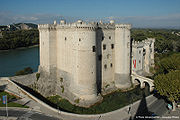
Bouches-du-Rhône
Bouches-du-Rhône is a department in the south of France named after the mouth of the Rhône River. It is the most populous department of the Provence-Alpes-Côte d'Azur region. Its INSEE and postal code is 13.-History of the department:...
Department, was begun in 1400 by Louis II of Anjou
Louis II of Naples
Louis II of Anjou was the rival of Ladislaus as King of Naples. He was a member of the House of Valois-Anjou.-Biography:...
,and finished by his son, Rene.
The Citadel
Citadel
A citadel is a fortress for protecting a town, sometimes incorporating a castle. The term derives from the same Latin root as the word "city", civis, meaning citizen....
of Sisteron
Sisteron
Sisteron is a commune in the Alpes-de-Haute-Provence department in the Provence-Alpes-Côte d'Azur region in southeastern France.Sisteron is situated on the banks of the River Durance just after the confluence of the rivers Buëch and Sasse...
, was built on a rocky spur overlooking the Durance
Durance
The Durance is a major river in south-eastern France.Its source is in the south-western Alps, in Montgenèvre ski resort near Briançon and it flows south-west through the following départements and cities:* Hautes-Alpes: Briançon, Embrun.* Alpes-de-Haute-Provence: Sisteron, Manosque.* Vaucluse:...
River on the strategic route through the Alps
Alps
The Alps is one of the great mountain range systems of Europe, stretching from Austria and Slovenia in the east through Italy, Switzerland, Liechtenstein and Germany to France in the west....
to the Mediterranean
Mediterranean Sea
The Mediterranean Sea is a sea connected to the Atlantic Ocean surrounded by the Mediterranean region and almost completely enclosed by land: on the north by Anatolia and Europe, on the south by North Africa, and on the east by the Levant...
. A Roman fort and a feudal castle first occupied the site. Then, from 1590 to 1597, Jean Erard,the military architect of king Henry IV, built a new kind of fortification designed to defeat armies with cannon and modern weapons. It featured walls laid out in a sawtooth pattern of recesses and salients,so all parts of the wall could be covered by gunfire; terraces and trenches to slow approaching armies; and interior walls and fortified gates to subdivide the fortress and prevent attackers from capturing it all in one attack. Many of these features were adapted and improved a century later by the military architect Vauban
Vauban
Sébastien Le Prestre, Seigneur de Vauban and later Marquis de Vauban , commonly referred to as Vauban, was a Marshal of France and the foremost military engineer of his age, famed for his skill in both designing fortifications and breaking through them...
.
The Age of Louis XIV in Provence (17th century)
The age of Louis XIVLouis XIV of France
Louis XIV , known as Louis the Great or the Sun King , was a Bourbon monarch who ruled as King of France and Navarre. His reign, from 1643 to his death in 1715, began at the age of four and lasted seventy-two years, three months, and eighteen days...
in Provence was marked by an increase in prosperity, after the destructive wars of religion in the previous century. The citizens of Arles
Arles
Arles is a city and commune in the south of France, in the Bouches-du-Rhône department, of which it is a subprefecture, in the former province of Provence....
built a new Hotel de Ville, designed by the Arles architect Jacques Peytret, aided by Jules Hardouin-Mansart
Jules Hardouin Mansart
Jules Hardouin-Mansart was a French architect whose work is generally considered to be the apex of French Baroque architecture, representing the power and grandeur of Louis XIV...
, which has a large central court with a perfectly smooth vaulted ceiling, without a central column, supported entirely by the carefully joined stones resting on fine doric columns. The Hotel de Ville symbolized the rise of the power of the bourgeoise of the French cities. and showed that civil architecture could be as beautiful and powerful as religious architecture or royal palaces.
Second Empire style (19th century)
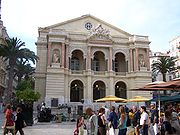
Toulon Opera
The Toulon Opera , inaugurated in 1862, is the second-largest opera house in France, after the Palais Garnier in Paris, and it is one of the country's national historic monuments. It is currently the home of the Opéra Toulon Provence Méditerranée, under the direction of Claude-Henri Bonnet...
, built in the flamboyant style of the French Second Empire
Second French Empire
The Second French Empire or French Empire was the Imperial Bonapartist regime of Napoleon III from 1852 to 1870, between the Second Republic and the Third Republic, in France.-Rule of Napoleon III:...
, was begun at the same time as the Paris Opéra
Palais Garnier
The Palais Garnier, , is an elegant 1,979-seat opera house, which was built from 1861 to 1875 for the Paris Opera. It was originally called the Salle des Capucines because of its location on the Boulevard des Capucines in the 9th arrondissement of Paris, but soon became known as the Palais Garnier...
of Charles Garnier
Charles Garnier (architect)
Charles Garnier was a French architect, perhaps best known as the architect of the Palais Garnier and the Opéra de Monte-Carlo.-Early life:...
, and illustrated the importance of Toulon as the main base of the French Navy. The architect was Leon Feuchéres. Construction was begun in 1860, and it opened in 1862. It boasted exceptional acoustics and seats for 1800 spectators, making it, after Paris, the second-largest opera house in France.
The Neo-Byzantine style (19th century)
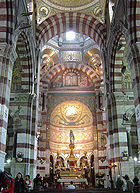
Basilica
The Latin word basilica , was originally used to describe a Roman public building, usually located in the forum of a Roman town. Public basilicas began to appear in Hellenistic cities in the 2nd century BC.The term was also applied to buildings used for religious purposes...
of Notre-Dame de la Garde
Notre-Dame de la Garde
Notre-Dame de la Garde is a basilica located in Marseille, France. This ornate Neo-Byzantine church is situated at the highest natural point in Marseille, a 162 m limestone outcrop on the south side of the Old Port. As well as being a major local landmark, it is the site of a popular annual...
in Marseille was built between 1853 and 1864 on the highest point in the city in the neo-Byzantine
Neo-Byzantine architecture
The Byzantine Revival was an architectural revival movement, most frequently seen in religious, institutional and public buildings. It emerged in 1840s in Western Europe and peaked in the last quarter of 19th century in the Russian Empire; an isolated Neo-Byzantine school was active in Yugoslavia...
style. It was finished ten years before its famous sister, the Basilica of Sacré-Coeur in Paris, was begun. It was designed by the architect Jacques-Henri Esperandieu. The main feature of the church is a 197 foot (60 m) belfry with a statue of the Virgin and Child, visible miles out to sea.
Rural architecture in Provence
The rural architecture of Provence features two distinctive types of farm houses, the masMas (Provencal Farmhouse)
A mas is a traditional farmhouse in the Provence region of France as well as in Catalonia, where is also named masia or masía ....
and the bastide
Bastide (Provencal Manor)
A Bastide is a local name for a manor house in Provence, in the south of France, located in the countryside or in a village, and originally occupied by a wealthy farmer...
.
A mas a largely self-sufficient economic unit, which could produce fruits, vegetables, meat, milk, and even silk. The house was usually built of local stone with a sloping Roman tile roof, and was a long rectangle, two or three stories high, with the kitchen and space for animals on the ground floor, and bedrooms, storage space for food, and often a room for raising silkworms on the first floor. As the family grew larger, the mas would be extended to make new rooms. The mas nearly always faced the south, to provide protection from the Mistral
Mistral (wind)
The mistral is a strong, cold and usually dry regional wind in France, coming from the north or northwest, which accelerates when it passes through the valleys of the Rhone and the Durance Rivers to the coast of the Mediterranean around the Camargue region. It affects the northeast of the plain...
and it had few and very small windows, to keep out the summer heat and to keep in the heat in winter.
A bastide was the house of a wealthier farmer, and usually was in the shape of a square, with an interior courtyard. In the 19th and 20th centuries many bastides were occupied by wealthy city residents from Marseille.
Corbusier in Provence (20th century)
The Unité d'HabitationUnité d'Habitation
The Unité d'Habitation is the name of a modernist residential housing design principle developed by Le Corbusier, with the collaboration of painter-architect Nadir Afonso...
in Marseille, also known as the Cité Radieuse
Unité d'Habitation
The Unité d'Habitation is the name of a modernist residential housing design principle developed by Le Corbusier, with the collaboration of painter-architect Nadir Afonso...
, designed by the architect Corbusier
Le Corbusier
Charles-Édouard Jeanneret, better known as Le Corbusier , was a Swiss-born French architect, designer, urbanist, writer and painter, famous for being one of the pioneers of what now is called modern architecture. He was born in Switzerland and became a French citizen in 1930...
in 1946-1952, became one of the most influential buildings of the 20th century. Built of unfinished concrete (steel was not available because of the war), it had nineteen stories with 330 apartments of twenty different designs, along with shops, a restaurant, a hotel, clinic, sports facilities, a roof terrace, an outdoor auditorium and a kindergarten. It was meant to be "a machine for living," with everything needed under a single roof. Corbusier built five versions of the Unite d'Habitation, and it inspired similar buildings in other parts of France, Germany and in Britain, and became a model for new apartment buildings and public housing
Public housing
Public housing is a form of housing tenure in which the property is owned by a government authority, which may be central or local. Social housing is an umbrella term referring to rental housing which may be owned and managed by the state, by non-profit organizations, or by a combination of the...
projects in the 1950s. It was praised and much criticized as the first example of brutalist architecture
Brutalist architecture
Brutalist architecture is a style of architecture which flourished from the 1950s to the mid 1970s, spawned from the modernist architectural movement.-The term "brutalism":...
.
Other buildings by Corbusier in Provence:
- Cabananon at Roquebrune-Cap-MartinRoquebrune-Cap-MartinRoquebrune-Cap-Martin is a commune in the Alpes-Maritimes department in southeastern France between Monaco and Menton. The name was changed from Roquebrune to differentiate the town from Roquebrune-sur-Argens in the neighboring Var Department.-History:In pre-Roman times the area was settled by the...
, 1952. Corbusier stayed several times in the Villa E 1027 in Roquebrune-Cap-Marin, and was commissioned in 1952 by Thomas Rebutato, the owner of a local restaurant, to build a beachside cabin, or Cabanon. It was limited to 16 square meters, was made of wooden logs and plywood, and was to be furnished with only a couch, a table, and a sink. It was part of Corbusier's effort to standarize every genre of architecture. Later he added a tiny office next to the cabin.
Modern architecture in Provence (20th century)
Notable 20th century buildings in Provence include:- The Archives d'Outre Mer (Aix-en-ProvenceAix-en-ProvenceAix , or Aix-en-Provence to distinguish it from other cities built over hot springs, is a city-commune in southern France, some north of Marseille. It is in the region of Provence-Alpes-Côte d'Azur, in the département of Bouches-du-Rhône, of which it is a subprefecture. The population of Aix is...
, 1996), architects Thierry Lacoste, Antoinette Robain - Villa Bloc (Antibes, 1961), architect André BlocAndré BlocAndré Bloc was a French architect, sculptor, editor, and founder of several specialist journals. He founded the "Groupe Espace" in 1949....
and Claude Parent - Musee d'Arles Antique (Arles, 1995), architect Henri Ciriani
- Rotonde des locomotives, (Avignon, 1946), architects Paul Peirani, Bernard Lafaille
- Eglise Saint-Joseph-Travailleur (Chamfleury, 1967–69) architect Guillaume Gillet, Charles André
- La Citadelle (Bagnols-sur-Ceze, 1956–1961), architects Georges Candilis, Alexis Josic, Sadrach Woods, Guy Brunache, Paul Dony
- Villa KerylosVilla KerylosVilla Kerylos in Beaulieu-sur-Mer was built in the early 1900s by Theodore Reinach, the famous French archaeologist and his wife Fanny Kann, a daughter of Maximilien Kann and Betty Ephrussi, of the Ephrussi family. The architect was Emmanuel Pontremoli. A Greek word, "Kerylos" means Halcyon or...
, Beaulieu-sur-MerBeaulieu-sur-MerBeaulieu-sur-Mer , Italian: Belluogo, is a seaside village on the French Riviera between Nice and Monaco. It is a commune in the Alpes-Maritimes department and borders the communes of Saint-Jean-Cap-Ferrat, Èze, and Villefranche-sur-Mer.-History:...
, (1903–1908), architect Emmanuel PontremoliEmmanuel PontremoliEmmanuel Pontremoli was a French architect and archaeologist. Born in Nice, Alpes-Maritimes, a student in the atelier of Louis-Jules André, in 1890 he won the Prix de Rome in the architecture category and in 1922 became a member of the Académie des Beaux Arts... - Hotel Carlton, CannesCannesCannes is one of the best-known cities of the French Riviera, a busy tourist destination and host of the annual Cannes Film Festival. It is a Commune of France in the Alpes-Maritimes department....
, (1909–1913), architect Charles Dalmas, Marcellin Mayére - Villa Vent d'aval, Grimaud, VarGrimaud, VarGrimaud is a commune in the Var department in the Provence-Alpes-Côte d'Azur region in southeastern France.It is located on the French Riviera. The village of Grimaud is a perched village, with historical links to the Grimaldi family. Gibelin de Grimaldi aided William the Good drive the Saracens of...
, 1928–1950, architect Pierre ChareauPierre ChareauPierre Chareau was a French architect and designer.-Early life:Chareau was born in Le Havre, France. He went to the École nationale supérieure des Beaux-Arts in Paris by the time he was 17.-Work:... - Centre de recherche IBM, La GaudeLa GaudeLa Gaude is a commune in the Alpes-Maritimes département in southeastern France.- History :La Gaude takes its name from a tool that was used for repairing fishing nets...
, (1960–1962)- architect Marcel BreuerMarcel BreuerMarcel Lajos Breuer , was a Hungarian-born modernist, architect and furniture designer of Jewish descent. One of the masters of Modernism, Breuer displayed interest in modular construction and simple forms.- Life and work :Known to his friends and associates as Lajkó, Breuer studied and taught at... - Villa Seynave, Grimaud, VarGrimaud, VarGrimaud is a commune in the Var department in the Provence-Alpes-Côte d'Azur region in southeastern France.It is located on the French Riviera. The village of Grimaud is a perched village, with historical links to the Grimaldi family. Gibelin de Grimaldi aided William the Good drive the Saracens of...
(1961) architect Jean Prouvé - Port-Grimaud, Grimaud, VarGrimaud, VarGrimaud is a commune in the Var department in the Provence-Alpes-Côte d'Azur region in southeastern France.It is located on the French Riviera. The village of Grimaud is a perched village, with historical links to the Grimaldi family. Gibelin de Grimaldi aided William the Good drive the Saracens of...
, (1963–1972, François SpoerryFrançois SpoerryAfter the war ended, he opened his first architectural firm in Mulhouse where he associated with a significant number of reconstruction projects. In Mulhouse, he was the planner of the new town centre. He also built in Mulhouse the Tour of Europe, the largest structure in contemporary France whose... - Villa de Noailles, HyèresHyèresHyères , Provençal Occitan: Ieras in classical norm or Iero in Mistralian norm) is a commune in the Var department in the Provence-Alpes-Côte d'Azur region in southeastern France....
, (1923) Robert Mallet-StevensRobert Mallet-StevensRobert Mallet-Stevens was a French architect and designer. Along with Le Corbusier he is widely regarded as the most influential figure in French architecture in the period between the two World Wars.... - La Tourette, Marseille, (1948–1953) architects Fernand Pouillon, Renė Egger
- Immeuble-facade du Vieux-Port, Marseille (1949–1954), architect Fernand Pouillon, Andre Devin, Andre LeConte, Auguste Perret
- La Brasilia, Marseille, (1957–1967) architect Fernand Boukobza
- École Nationale de Danse, Marseille (1992) architect Roland Simounet
- Hotel du département, Marseille, (1993) architects William Alsop, John Lyall
- Théâtre des Salins, MartiguesMartiguesMartigues is a commune northwest of Marseille. It is part of the Bouches-du-Rhône department in the Provence-Alpes-Côte d'Azur region on the eastern end of the Canal de Caronte....
, (1995), architects Vincent Speller, Xavier Fabre, Marino Narpozzi - Le NegrescoHotel NegrescoThe Hotel Negresco on the Promenade des Anglais on the Baie des Anges in Nice, France was named for Henri Negresco who had the palatial hotel constructed in 1912...
, NiceNiceNice is the fifth most populous city in France, after Paris, Marseille, Lyon and Toulouse, with a population of 348,721 within its administrative limits on a land area of . The urban area of Nice extends beyond the administrative city limits with a population of more than 955,000 on an area of...
, (1911–1913), architect Édouard-Jean Niermans :fr:Édouard-Jean Niermans - Eglise Sainte-Jeanne-d'Arc, Nice, (1922–1933), architect Jacques Droz
- Musée des Arts asiatiques, NiceNiceNice is the fifth most populous city in France, after Paris, Marseille, Lyon and Toulouse, with a population of 348,721 within its administrative limits on a land area of . The urban area of Nice extends beyond the administrative city limits with a population of more than 955,000 on an area of...
((1998), architect Kenzo TangeKenzo Tangewas a Japanese architect, and winner of the 1987 Pritzker Prize for architecture. He was one of the most significant architects of the 20th century, combining traditional Japanese styles with modernism, and designed major buildings on five continents. Tange was also an influential protagonist of... - Espace Clodius, Orange, (1997), architects Michel Seban and Elisabeth Douillet
- Villa Ephrussi de RothschildVilla Ephrussi de RothschildVilla Ephrussi de Rothschild is a French seaside palazzo constructed between 1905 and 1912 at Saint-Jean-Cap-Ferrat on the French Riviera by Baroness Béatrice de Rothschild in the Goût Rothschild. It was designed by the Belgian architect Aaron Messiah...
, also known as the Villa Ile-de-France, in Saint-Jean-cap-FerratSaint-Jean-Cap-FerratSaint-Jean-Cap-Ferrat , Italian: San Giovanni Capo Ferrato, is a commune of the Alpes-Maritimes department in southeastern France.It is located on a peninsula next to Beaulieu-sur-Mer and to Villefranche-sur-Mer and extends out to Cap Ferrat...
, (1911–1912) architect Aaron Messiah - Fondation MaeghtFondation MaeghtFondation Maeght is a museum of modern art situated in Saint-Paul de Vence in the south of France about 25km from Nice. It was founded by Marguerite and Aimé Maeght in 1964 and houses paintings, sculptures, collages, ceramics and all forms of modern art....
, Saint-Paul-de-VenceSaint-Paul, Alpes-MaritimesSaint-Paul or Saint-Paul-de-Vence is a commune in the Alpes-Maritimes department in southeastern France. One of the oldest medieval towns on the French Riviera, it is well-known for its modern and contemporary art museums and galleries such as Fondation Maeght which is located nearby.The property...
, (1960–1964), architect José Luis SertJosep Lluís SertJosep Lluís Sert i López was a Spanish Catalan architect and city planner.- Biography :Born in Barcelona, he showed keen interest in the works of his painter uncle Josep Maria Sert and of Gaudí. He studied architecture at the Escola Superior d'Arquitectura in Barcelona and set up his own studio... - Villa E 1027, Roquebrune-Cap-MartinRoquebrune-Cap-MartinRoquebrune-Cap-Martin is a commune in the Alpes-Maritimes department in southeastern France between Monaco and Menton. The name was changed from Roquebrune to differentiate the town from Roquebrune-sur-Argens in the neighboring Var Department.-History:In pre-Roman times the area was settled by the...
, (1926–1929), architects Eileen GrayEileen GrayKathleen Eileen Moray Gray was an Irish furniture designer and architect and a pioneer of the Modern Movement in architecture.- Biography :...
and Jean BadoviciJean BadoviciJean Badovici was an Romanian architect and architecture critic active in Paris.- Biography :Born in Bucharest, Romania, Jean Badovici studied architecture in Paris after World War I. Since 1923 he edited the important French magazine for avantgarde architecture L'Architecture Vivante... - Latitude 41, Saint-Tropez (1932–33), architect Georges-Henri Pingusson
- Villa Dollander, Saint-Clair, (1949–1951, architects Henri Prouvé and Jean Prouvé
- The Stadium of VitrollesVitrolles, Bouches-du-RhôneVitrolles is a commune in the Bouches-du-Rhône département in the Provence-Alpes-Côte d'Azur region in southern France. It is the largest suburb of the city of Aix-en-Provence and is adjacent to its southwest side.-Population:-Administration:...
(1994), architect Rudy Ricciotti - Eglise-mairie, ValbonneValbonneValbonne Sophia Antipolis is a commune near Nice in the Alpes-Maritimes department in the Provence-Alpes-Côte d'Azur region in south-eastern France...
, 1988–1989, architects Pierre Faroux, Bruno Keller - Port-la-Galère, Théoule-sur-MerThéoule-sur-MerThéoule-sur-Mer is a commune in the Alpes-Maritimes department in southeastern France.-Population:-References:*...
, (1968–1979)
The 21st century

LGV Méditerranée
The LGV Méditerranée is a French high speed railway line of approximately 250 km length, which entered service in June, 2001. Running between Saint-Marcel-lès-Valence and Marseille, it connects the regions of Provence-Alpes-Côte d'Azur and Languedoc-Roussillon to the LGV Rhône-Alpes, and from...
high-speed train line in South-eastern France
France
The French Republic , The French Republic , The French Republic , (commonly known as France , is a unitary semi-presidential republic in Western Europe with several overseas territories and islands located on other continents and in the Indian, Pacific, and Atlantic oceans. Metropolitan France...
, innaugurated in 2001. It was designed by the cabinet of architecture of the SNCF
SNCF
The SNCF , is France's national state-owned railway company. SNCF operates the country's national rail services, including the TGV, France's high-speed rail network...
under the direction of Jean-Marie Duthilleul and Jean-François Blassel. Its gothic arches echo the most famous landmark in Avignon, the Palais des Papes (see above.)

